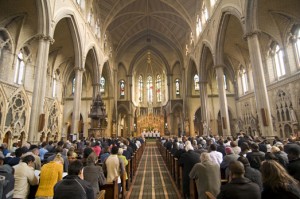Thanks for indulging me in my desire to lure traditionalists into ordinary form parishes. While you may disagree with this being a workable solution to the liturgy wars, I hope at least that it starts a conversation about how we should improve relations between traditionalists and the wider Church.
Now in your last piece [2], I like how you clearly articulated the uniqueness of desires of our millennial generation with regards to things like the liturgy and church architecture:
Is demand for a reverent liturgy sparse? There’s some evidence for that, but there’s also some evidence opposing that idea. This is especially the case when you consider our generation. As the Center for Research in the Apostolate found in a 2013 survey, things like Church Architecture, a reverent liturgy, and a strong identity with Catholic teaching are the things that define Catholicism for the millennial generation. Unlike their ancestors, they are also more than willing to hop from parish to parish until they find it.
While I do think demand for a truly reverent liturgy is relatively low among Catholics overall in the United States, I absolutely agree that our generation of Catholics holds a deep desire for a more reverent Mass. This is an implied thesis in the initial piece I wrote that was the catalyst for this dialogue. It’s clear that Catholics who grow up and decide to stay in the Church are likely to be more conservative than their parents, if not more becoming full on traditionalist. This phenomenon is a cultural and spiritual consequence of bad liturgy and felt banner catechesis. And if we learned anything from “that 70’s Church,” it’s that interesting things happen when the pendulum swings too far in one direction.
I would like to provide to readers, from my own lens and experience, what this pendulum swing looks like. Instead of quoting journalists or citing statistics, I’d simply like to tell this story through an archetype of a Millennial Catholic many of us (but perhaps few in the leadership) are familiar with.
I’ll call this archetype Russ.
Russ grew up in a small Chicago suburb. He and his family faithfully attend “Mary Mother of the Church”, which describes itself as an “inclusive Catholic community.” It’s a bland circle church with a modern, abstract crucifix hanging from the rafters. “Pastor Dave’s” homilies provide some insight into the life of Christ, but they’re mostly geared towards helping upper middle class suburbanites feel better about their hectic, competitive lives. The hymn “All are Welcome” is sung at Mass at least once a month. About 95 percent of parishioners in attendance receive communion at any given service. Less than a quarter have ever attended reconciliation at Mary Mother. To his knowledge, Russ’s parents have never attended either.
Russ is a curious and intelligent kid. And surprisingly, more than videogames and comic books, he enjoys his Catholic faith. By age 13, he’d read the Wikipedia pages of all the Popes from the last 100 years. By 15, he could cite a handful of codes from Canon law. Russ consumed Catholic knowledge the same way most kids his age were consuming television.
Because so much Catholic content online references the Council in some way, curious Russ eventually became interested in Vatican II. Because he desired something more than what his parish gave him (he wished Mass looked and sounded more like the baptism scene from the Godfather) Russ was particularly focused on the changes in the Mass. As we know, the study of Vatican II is like taking the red pill in the Matrix; you stop living in the dreamworld. You realize that the consensus you thought all good conservative Catholics had about the faith and history was an illusion. Why the Church is in the shape it is; whether or not there’s a “crisis”, the reason for this crisis, and even seemingly small things like the way in which you receive communion. These topics are all vigorously debated online. Given his experience at Mary Mother, Russ becomes convinced that liturgical and cultural chances of the past 50 years are responsible for the crisis. His Youtube account begins recommending videos like “Vatican II: Council of Apostasy” and various episodes of The Vortex.
At this point, a visible change has taken place in Russ. He’s become something of a hardliner. Russ’ favorite Catholics are St. Athanasius and St. Pius X. His favorite diagnosis of Church problems is “modernity” and “protestantism”.
Is Russ a problem or solution to the crisis? Will he be a divisive force within the Church? Can his worldview be reconciled with Pope Francis? Does it have to be?
I don’t mean to use “Russ” to pigeonhole all Catholics of a traditionalist bent. But I do think this story typifies the journey to traditionalism many people Catholics now in their early 20’s have been on. If nothing else, we should be sympathetic and understanding to Russ, given the kind of Catholicism he was raised in. But I do think the above questions are important and ones that readers of this dialogue should consider.
